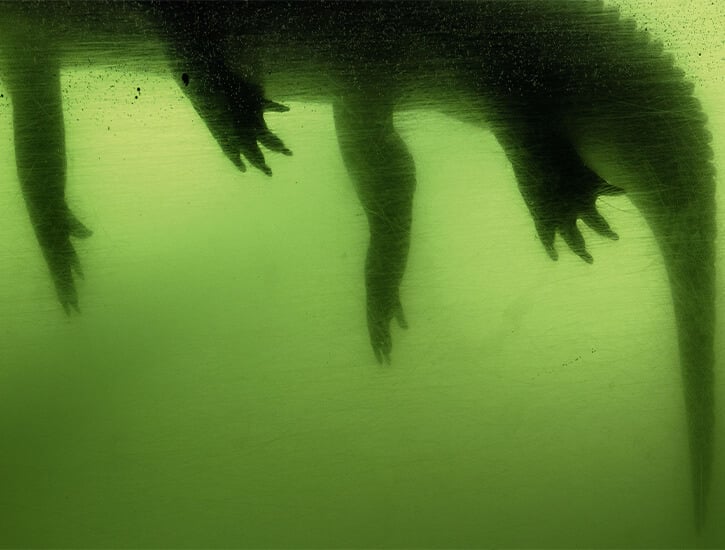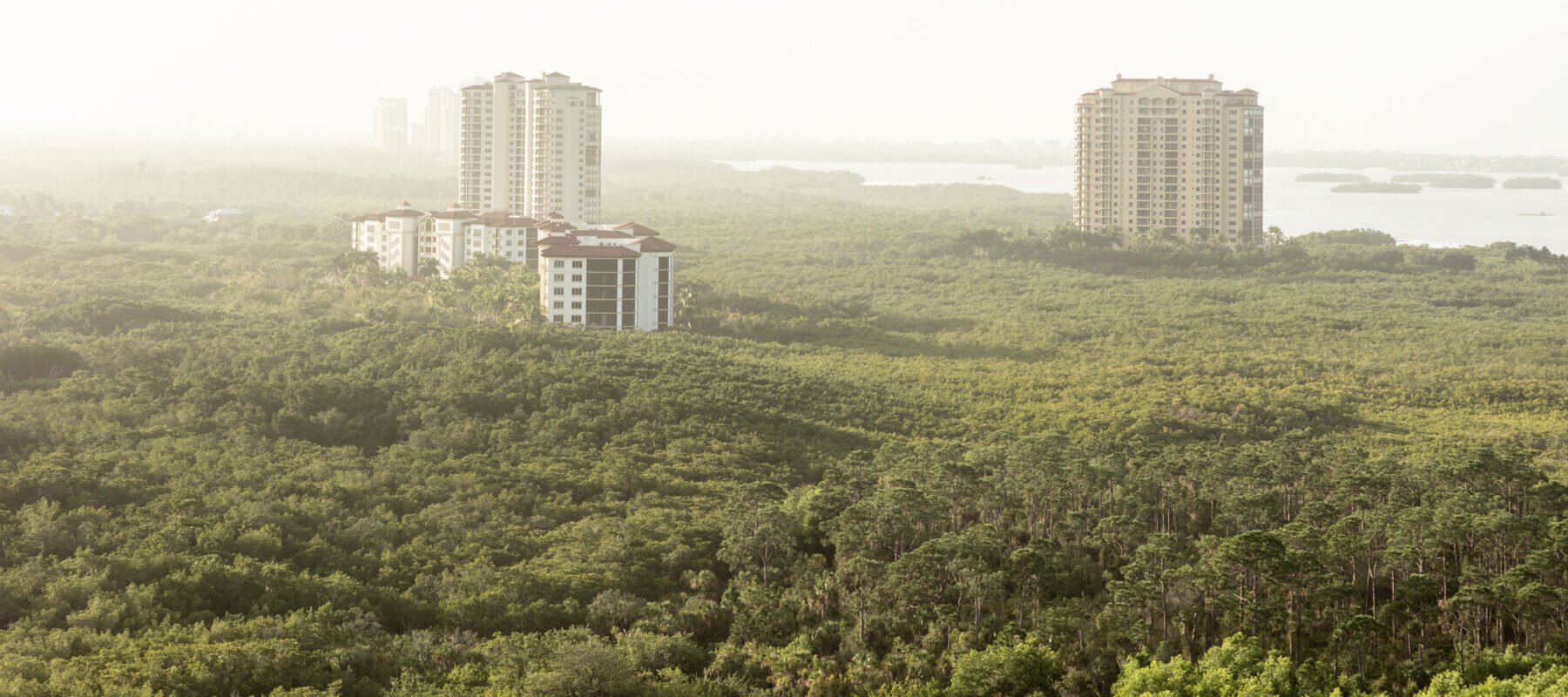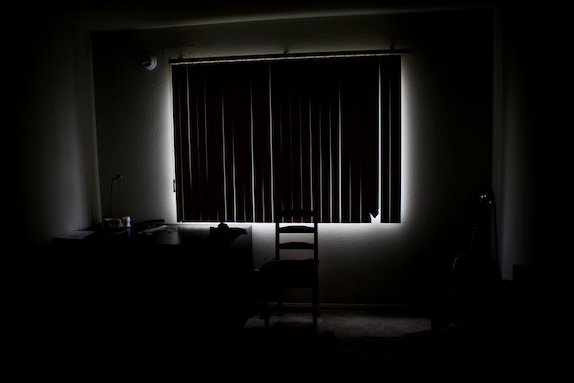The Infinite Previous
The Infinite Previous
Images of Florida From FloodZone(2019). | Anastasia Samoylova
From FloodZone(2019). | Anastasia Samoylova o
r
d
F
a
c
t
o
r
y
FloodZone by Anastasia Samoylova. Steidl, 136 pages.
Floridas by Anastasia Samoylova and Walker Evans. Steidl, 192 pages.
The southernmost of the continental United States, the so-called Lower Forty-eight. Where better shoot for space, publicly or now privately, than from the flattest and lowest and most unstable of them all, its highest point barely a hundred yards up in the soggy air? A plump peninsular dangle haunted by the promise of its physical (dis)appearance decades hence, or, the way things are going, sooner than that—shrunk to bone (it has no bone, there is no bone), hence merely atrophied and shortened to a carious stumpy shrivel or wizen, ending at maybe Orlando, all the rest taken back by the Atlantic and the Gulf. And presumably still impeccably gerrymandered. Well, easy come, easy go, as is not—but might as well be—the state’s motto (which, if you must know, is “In God We Trust”).
From the air, it is cities, bays, jungle, and mottling—what the booksellers call foxing—like a form of rot; a level scape of little mushrooms on blotting paper; a pointillist blotch; the dotting of millions or billions of lakes and ponds among the slabs of forest and field and just swampy spare ground waiting to appreciate; the round clumps of “tree islands,” sometimes called “hammocks” in the palmetto and vine scrub; sinkholes as much a possibility as mobile homes, like the holes in Swiss cheese, sinkholes popping up—popping down—in the porous limestone when the sand plugging them abruptly drains out of them. Gridded by highways meeting at infinity, and then the plops of the round ponds. Round and straight, round and straight, like so many noughts and crosses. Inadequate separation of earth and water, the world as if God had thrown in the towel after Day Two. (And when it teems with bouncing white rain, Day One.) Brown when wet, tan when dry, gray when grown over by the duopoly of pines and palms. Dark wiggling meanders (where is the gradient that would straighten them out or speed them up?), the color of tea from the amount of leaf matter swilled out of the sandy ground, and old white dead straight—no, not authors—roads, silver in the sun, made from sand or crushed shells.
I’ve long thought: humans were never intended to live here. Perhaps, in a sense, we don’t; only our money does.
Water is a constant—or rather, an inconstant—mystery, our own prairie that half the time is a lake (we think of it as something like Zola’s Le ventre de Paris, a frenzied frog-eat-frog mutual gourmandize among water-, earth-, and air-creatures); water filling up the underground limestone caverns and spilling out of them at great pressure and purity in the springs of the Santa Fe and the Suwanee (the rights to extract and bottle billions of gallons of it obtained for a pittance by Coca Cola and others), and disappearing to leave behind aridity, sand, and death. So flat, so soft, so rootless, so yielding, so accommodating to invasives and (some) incomers, the pet boa constrictor unspooling out of the toilet, the armadillo hoofing it up from Texas at the rate of a few yards a year, the Cuban migrant crawling ashore, wet-foot or dry-foot, the armed and dangerous jail-break making a beeline for us, the totemic beasts we are known for and are sentimentally pleased to slap on our license plates—the Florida panther, the manatee—imperiled and all-but-gone; a landscape formed by bulldozer as by butter knife from the flat, resistless, featureless plain; no hill, no rock, no soil, slash pines cleared into heaps and middens to make space for new condo developments, with natural or British-sounding or misspelt tony names (the flamingoes or magnolias that were driven away to make this), where an influx of disappointed new or hopeful old people can dwell in brief comfort in system-built high-rise among the low-rise, cheek by jowl with their cars.
We are perhaps used to thinking of the clash of nature and culture; in Florida, there is no culture, no landscape that leaves a stable record of the effects of human settlement. It is more garish, more conflictual than that, more primal or more modern. It is the clash of nature and money. Subtropical nature and hot money, at that, or at the very least, warm, humid, sweaty money. Pecuniamaybe doesn’t olet, but itsudet. The waves of greed and panic, panic buying, panic selling, the land booms and real estate busts, remote ownership, in-your-face ownership; railway barons and cattle barons and trumpery barons; the South a more troubled, less idyllic, less familiar, less idealized version of the West, at best, it’s “go South, old man,” or “Florida and bust!” A less favored version of California, without the rich farmland of Central Valley or the corn of Hollywood or a swamp to call Silicon; a state where things somehow didn’t take as well or as dependably, second in cattle, second in oranges, Florida permanently prox. acc., (though for all our other curses, we don’t have earthquakes; they have the Big One, we have lots of Little Ones, not earthquakes, but all manner of other plagues and pestilences).
The population dribbles down from the true South to this south-of-the-south otherwise populated by Canadians and people from Jersey; there are few born Floridians and far fewer still who have lived there for generations. The people, then, are as shallow rooted and either as vicious or as pampered as the nature (a lawn is not a natural product), living not much differently from the grass off sunshine and bottled water and botanical supplements; long-stay holiday makers, trippers, climate refugees, retirees, gone semi-permanent; to Jacksonville and Miami, cities that barely existed a hundred years ago, and gradually filling in the rest of the place, even the north, even bang inland (why, hello there, Villages, or should that be, The Villages!?), where my university, a party school without a beach to call its own, squats in a neo-sprawl that once gloried in the name of Hogtown, before collecting its next name from a Confederate general, where once there were only Indians and poor Blacks and poor whites, so-called Crackers (from the crack of whips or the crack of dried maize for distilling moonshine, take your pick), before the twin miracles of refrigeration and A/C made that familiar, but reliably disturbing inside-out effect of Florida, where the outside is kept blood-warm and the inside is cold enough to require a jacket. Nature and money. Howdy-doody.
In Florida, one is always surrounded. One is a spot in a spot in the tangle, like Sleeping Beauty. The tangle is always coming in. Think of Wallace Stevens’s “Anecdote of the Jar”: “I placed a jar in Tennessee . . . It did not give of bird or bush, / like nothing else in Tennessee.” Tennessee maybe keeps its distance; Florida doesn’t. Any jar here is soon grown over. Trees overtop the house with their rot-prone limbs, and snakes and critters and roots undermine it. The residents put up security lights and embed high-tech termite traps, hack back growth, set out roach motels, buy opossum insurance, and commit to yard contracts. In the long run there is no long run: none of it works. If there’s a mosquito-borne disease in Brazil, it’s in Florida.
Florida isn’t even an island that isn’t even an island. The tangle keeps coming in, lashed out of the sand by rain and sun. The long-established local firms, Oceans’R’Us and Insect & Insect and Cellulose Unlimited and Spore and Sons, all outperform our own investments. Yes, we are an encroachment, but everything else encroaches better. I’ve long thought: humans were never intended to live here. Perhaps, in a sense, we don’t; only our money does, and after that our ashes, stashed in the chichi pet cemeteries. Wherever one is is a sort of porthole. Except on the coast, there are no vistas, no expansive views, no horizons, no change. Florida cowboys managed without seasons or mountains. Big, top-heavy trees, identikit palmettoes, alligators, creepers, silence. The heat confines, the humidity confines, the rain confines, the bush confines. And driving—that stand-by, the American form of release—set the cruise control, lock the wheel, stick your foot out the window or both feet, and go as slow as you like through the maddening monotony.

And such a place—how does it photograph? With no Renaissance recessional perspectives, no pale remembered hills, with fierce light and black shadows and swift, vulgar sunsets? Well, either like Clyde Butcher (out of Ansel Adams), in black and white, or more accurately, dark silver gelatin and lustrous black, amphibious scenes before or after Homo sapiens, the photographer standing up to his middle in water, patient as Saint Sebastian, eavesdropping on swamps: the flaring cypresses, water lilies in the placid murk, heterogeneous growth resolved to organic geometry, the sensational thunderheads, stewed but distinct. Each picture seems like a distillation of thousands of years. The Florida of the “infinite previous.” Or else—a new discovery for me—an urban color photography of now, as beautiful in its way, witty and parlous and contingent, by the much younger, Moscow-born photographer, Anastasia Samoylova, who has been based in Miami Beach since 2016. It’s not humanistic—there are few portraits or human scenes—but in its sense of “Look! I have seen this!” it bears some affinity to the great twentieth century city photographers, Kertész or Brassaï.
Steidl has brought out two books of her photographs, one green cloth, one pink cloth, both sumptuous. FloodZone(2019)—the title suggests a new name for, and from, “Florida”—investigates the hard-drawn, though now rapidly softening edges of the state, in the wake of Hurricanes Irma and Maria, the collisions between natural and man-made, animal and mineral, ground and water. If there was a motto, it might be the American neo-Ozymandian message de nos jours: “Look on my works, ye feeble, and despair.” The photographs themselves don’t come with titles or locations—nothing limits the applicability and resonance of each—but I’m guessing most of them are South Florida. FloodZoneavoids both principal Florida traps: it is neither dramatic news photography nor glamor shots; it says neither “Crisis!” nor “Cor!”; it is not propagandistic or didactic. At the same time, these are not neutral photographs. The feeling of the pictures is seedy, battered, exhausted, even foolish. A swimmy image of a manatee in a canal, like a trapped cloud, bumping its nose against the substructure of a road; a cock and hen strutting down a sidewalk with parked cars; a man with hat and umbrella looking across the road on a glaring hot day at another man walking in the shade; part of a snake, but neither head nor tail; part of a flamingo’s neck; fresh lichenous growth in a motorboat, a car, on the façade of a building.
Human scale can be hard to find; we are in a place that lends itself to mirages.
Samoylova is drawn to painted colors, pinks and greens and blues, and the roughened-up textures of rust, mold, moss, fallen leaves, scabbed paint. The photographs do work as dreamily precise near-abstract images and yet at the same time answer anthropological questions about how we live, what we desire and fear, how manipulable we are. She enjoys having a multiplicity of surfaces, graffiti, tags, slogans, murals, placards, reflections. Human scale can be hard to find; we are in a place that lends itself to mirages. The profile of a vast cargo ship slides past a dock. A car windscreen shader is a ripple-effect swimming pool. A picture of cumulus clouds and spray and blue sky is wedged in among rusty pipes and chains and valves. Many of the pictures look like clamorous composites, carrying different visual levels like a trompe l’oeil, reminding one of her earlier kaleidoscopic cut-together landscape objects (from a 2013 series called Landscape Sublime). There is, reading from bottom to top, a slice of concrete sidewalk; a foot or so of bare earth and a stout pine post; and the remaining nine-tenths—like an upside-down iceberg—reaching up and out: a photographic poster idyll of high apartment life, with pool, concrete and glass architecture, low-slung furniture. What’s real here? it seems to ask. Your name where? A lawn sprinkler or maybe a garden feature fountain continues to spray, like Breughel’s Icarus almost unnoticed, burbling away to itself while well underwater at the back of a walled residential compound, with pool and loungers, and a white pickup truck, the standard issue escape vehicle, parked out front, as with so many Floridian dwellings. Construction site shaders show the aspirational, the unaffordable, the ideal standard (which is of course the name of a make of lavatory), the expensive, the spookily deserted; while displaced to either side is wreckage, relegated, recrudescent nature, straightforward shabbiness. Many pictures are marked by defensive lines, themselves not in the best shape: wire mesh fences, edged lawns, the top of a building secured with a line of trophy car doors and loops of razor wire, a car in its driveway grinning behind bars like a lion. The atmosphere is apprehensive, not to be trusted, a patched-up dream; this world is gaudy and fearful. It ages quickly, stands in need of continual renewal, and is quite possibly facing the wrong way.
The pink book is Floridas, published this year (I thought of Rimbaud’s “incroyables Florides” from the “Le Bateau Ivre”). A bigger format (large landscape instead of portrait, thirty-one by twenty-seven centimeters, instead of twenty-seven by twenty-three), and a bigger and heavier book (one hundred forty images, as opposed to ninety-odd), the photographs this time titled and placed, the pages numbered for ease of reference, a longer text by David Campany, a little story by Lauren Groff about the dream of escaping to Miami overnight—like Where the Wild Things Are—and getting home in time to make breakfast for her family. And an interleaving of Samoylova’s photographs with some by Walker Evans, a regular and enthusiastic visitor to Florida over several earlier decades.
It sounds possibly contrived; it’s anything but. Samoylova didn’t set out to match or outdo Evans’s pictures one by one, or revisit his subjects and redo them. She chose, as it were, “real” photographs of her own, and put them in dialogue with his (and, importantly, with her own). It’s not call and echo, it’s a conversation. Crucially, eight or ten of his naïve paintings of shacks and huts and palms are included as well, objects of a different kind, which elicit perhaps a more tender, wistful response. He has a painting of a pink and gray hut on stilts over water; on the facing page, she has a baby crocodile in a blue-tiled and pink-walled basin, grinning in that way they have as he takes a shower under a white plastic overflow pipe. The pink and blue speak to each other almost as the poems on facing pages. We see photographs linked by color, by texture, by form. A flamingo and a dangly double-jointed metal construction (“Abandoned Tourist Attraction”). He has a black and white photograph, “Racetrack Spectators,” the upper bodies of a suited man and two women standing, two other men sitting, medium distance, the large capital letters “MES” taking up the whole of the bottom half of the shot. Opposite, she has the window of a sandwich shop, the word “SANDWICH” in red-rimmed white capitals over a grid of chicken wire, then a wooden partition, then “Carmen’s Daily Special” in red letters that look like neon but probably aren’t, over some bunched, sagging Venetian blinds. It’s the horizontal wooden line in the middle that links the pictures—as it were, gives them some common element to talk about. She has a color shot of a wall—it looks almost like a Schwitters, the smeary scrappiness of it, a certain, chance, leftover quality, the suggestion that something nevertheless important is being unconventionally communicated, splashes of color (yellow and blue and red) and a dark, but sun-exposed, poster of a man’s face, without any text but heavily blacked out by four disapproving vertical double-lines. What’s left from this spontaneous redaction is a much-lightened blue coat shoulder, a white shirt-collar with bleached but still shiny red tie-knot, a flabby outsized ear, awful strawberry-porous skin on one chin, and the makings of a couple more below it, and the staring pupil of his left eye, all under a coarse thatch of Shredded Wheat. Opposite is a Walker Evans photograph of a Ringling Brothers Circus, with a torn tiger, and one thinks: noble beast.
The color pictures tend to be hers, but he made some color shots as well; and she includes some of hers in black and white. But as it’s not call and echo, it’s not identify-the-photographer either. The paintings, though, are all his. Here’s one of a concrete blockhouse, off-white, flat roof, a door and a window, flanked by pine-frond palms under a cobalt sky. Along the bottom is a line of gray ground. He has signed it in the bottom righthand corner. She, on the facing page, has gray running down the left edge of the shot—shadow, most likely—and then a close-up of a piece of rusty, blue-painted metal in the form of an arrow pointing from top left to bottom right. It’s perhaps a hinge or the leftover of a sign. The blue and gray, obviously, speak to each other, from picture to picture. But also, on the sign, there’s a curlicue, and then it reads, I think: “Geo. L. Mesker & Co. Ironworks” and then, “Evansville, Ind.” The “Evans-”, I like to think, is the point: it’s a great photographer’s reverence before her great predecessor.
本文地址:http://panshare.cn/guoxueshici/
版权声明
本文仅代表作者观点,不代表本站立场。
本文系作者授权发表,未经许可,不得转载。
